全文HTML
--> --> -->武汉国家脉冲强磁场科学中心(以下简称武汉强磁场中心)自建成以来, 多项技术指标达到国际一流水平[13], 目前最高磁场达90.6 T, 电源设计、磁体技术和测量水平位列世界前沿. 依托此脉冲强磁场大装置平台, 本文提出了具有拉杆式传动结构的转角样品测量杆, 研制了转角电输运测量系统, 在强磁场和极低温等极端实验条件下, 实现了磁电阻、霍尔电阻等参数的精准测量, 为研究材料在强磁场下的物理特性提供了有效的研究手段[14], 有力支撑了凝聚态物理中的相关前沿科学问题如近藤效应、高温超导、量子霍尔效应、拓扑量子材料等课题研究的深入发展[15-17].
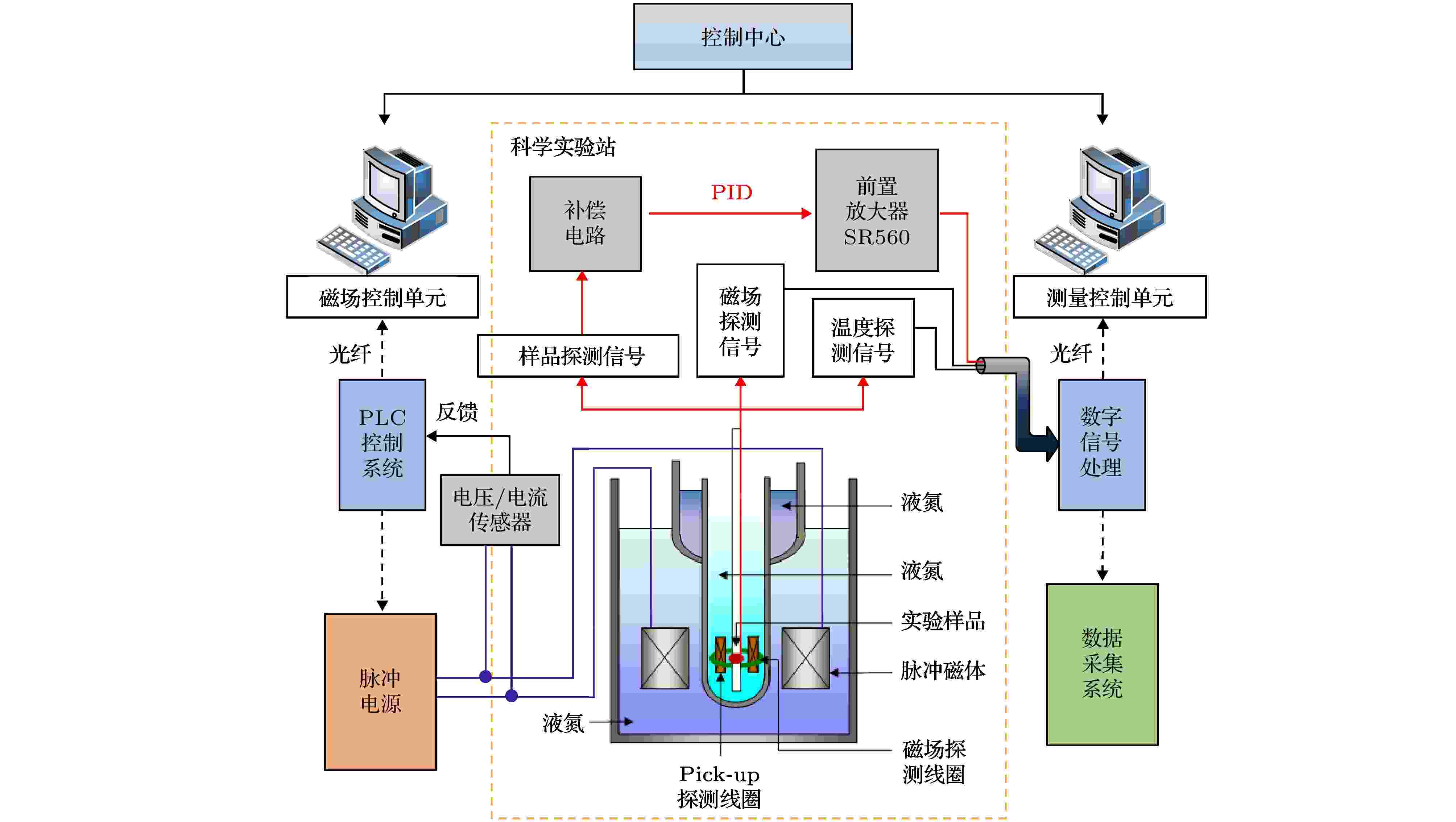 图 1 脉冲强磁场电输运测量系统
图 1 脉冲强磁场电输运测量系统Figure1. Electrical transport measurement system in pulsed high magnetic field.
其中, 信号采集单元中的测量插件转角样品杆是一个特殊的精密仪器部件, 它用于搭载极小样品及微型pick-up线圈, 并深入磁体孔径中心处. 科学实验中针对不同类型的样品, 样品杆的机械结构及搭建的电路布局也不相同. 因此, 为满足各类新材料相关物理性质的测量要求, 设计出适用于极端环境及狭小空间的转角样品杆, 是转角电输运测量实验顺利开展的基础和前提.
传统稳态强磁场所用的金属结构转角样品杆如图2(a)所示, 杆件整体框架和齿轮结构均由金属材料制成, 宽度约为25 mm, 适用于较低场下的PPMS物性综合测量系统[8]. 然而在脉冲场中, 一方面由于脉冲磁体孔径空间小, 严格限制了样品杆宽度必须小于9 mm, 稳态场下的样品杆尺寸无法满足要求; 另一方面, 受脉冲电流感应涡流的影响, 沿用稳态场中使用大量的金属材料制作转角杆的传统方法显然是不合适的.
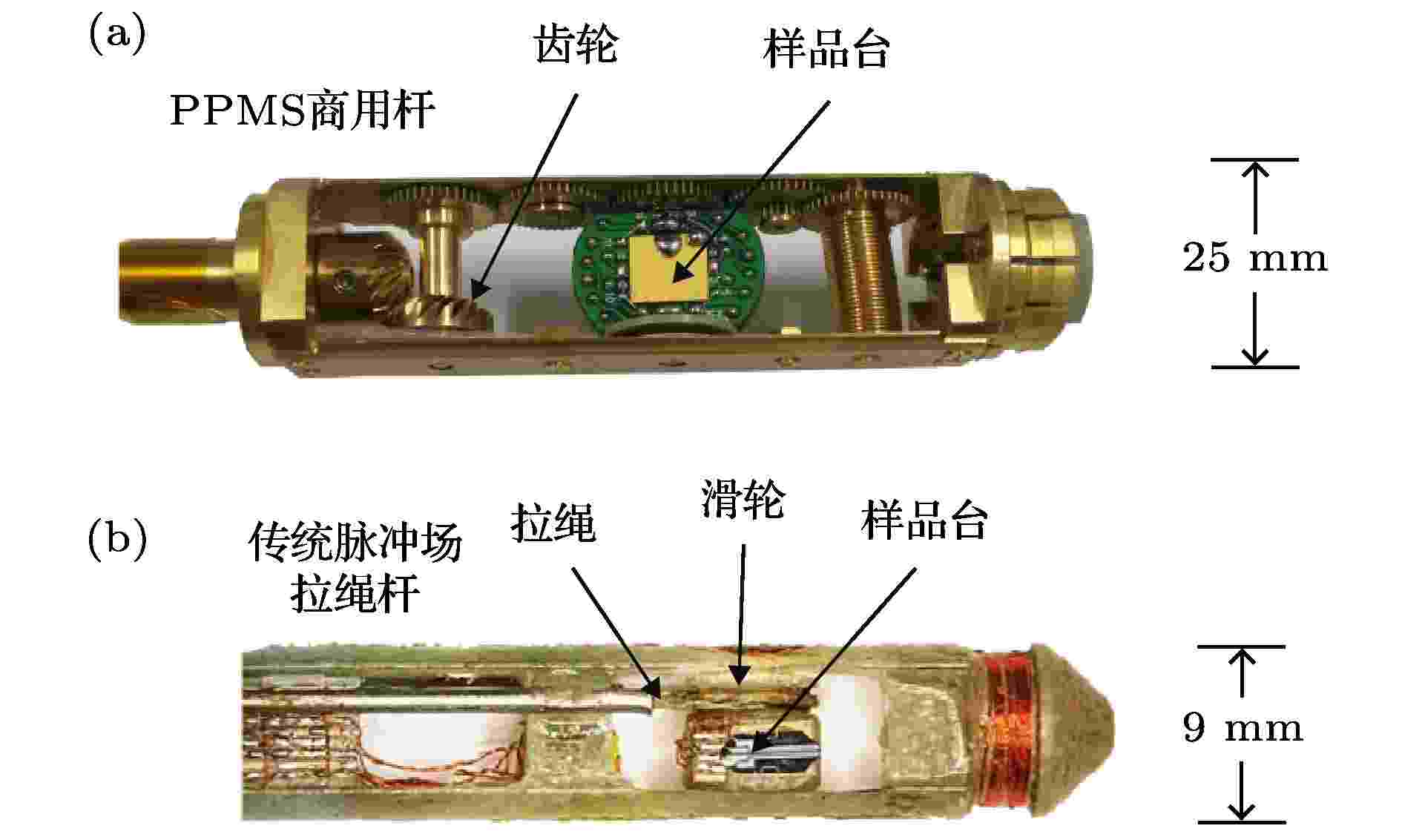 图 2 国内外已有转角样品杆 (a) 稳态强磁场中使用的探测样品杆; (b) 美国国家脉冲强磁场中心样品杆
图 2 国内外已有转角样品杆 (a) 稳态强磁场中使用的探测样品杆; (b) 美国国家脉冲强磁场中心样品杆Figure2. Rotation sample rod in: (a) Steady-state strong magnetic field; (b) NHMFL (National High Magnetic Field Laboratory).
现有脉冲场环境下, 目前国外相关实验室通常使用拉绳牵引滑轮的结构来研制转角样品杆 [20,21], 其宽度约为9 mm, 如图2(b)所示. 然而, 这种拉绳结构的线材温度伸缩系数较大, 在极低温下非常容易损坏, 存在角度控制精度较差、摩擦力不足导致回拉易打滑等问题. 同时, 由于滑轮与样品台并行排列, 占用了本就有限的样品台空间, 导致该结构的空间利用率低, 当样品尺寸较大时, 难以满足测量需求.
2
3.1.拉杆式转角样品杆的结构设计
为了解决以上问题, 设计了一种新型的基于多重拉杆结构的转角样品杆, 其旋转杆内部机械结构如图3(a)所示, 其中, 1是角度控制旋钮, 2是带有螺纹的传导管, 1与2分别作为螺母和螺杆, 共同构成螺栓结构. 转动旋钮螺母时, 带动螺杆2做上下移动; 3是传动杆, 4是水平滑槽, 5是斜滑槽, 4和5同时对3进行限位, 使其仅有一个位移自由度, 保证了运动轨迹的唯一性. 通过交叉滑槽结构控制传动杆, 只需要在样品台背面取一个支撑点6, 即可形成杠杆结构, 实现–5°—185°转角功能. 其转角为0°, 90°, 180°时, 机械结构状态如图3(b)所示. 其中位于样品台背面的7是角度标定线圈, 用于检测样品台的旋转角度, 8是温度计, 即热敏贴片电阻, 用于实验过程中测量样品台的即时温度; 9是样品台正面, 用于搭载样品并固定引线, 一般通过四线法来测量样品的磁阻、霍尔电阻等参数. 这种旋转机构中传动杆下方支点通过样品台背面的转轴孔与样品台连接, 从背面带动样品台旋转, 不占用样品台正面空间, 从而最大限度地保留了样品台面积, 较传统方式有更高的空间利用率, 最小可以在直径7—9 mm的圆柱空间内使用, 在测量准确度和可靠性方面均取得有效提升.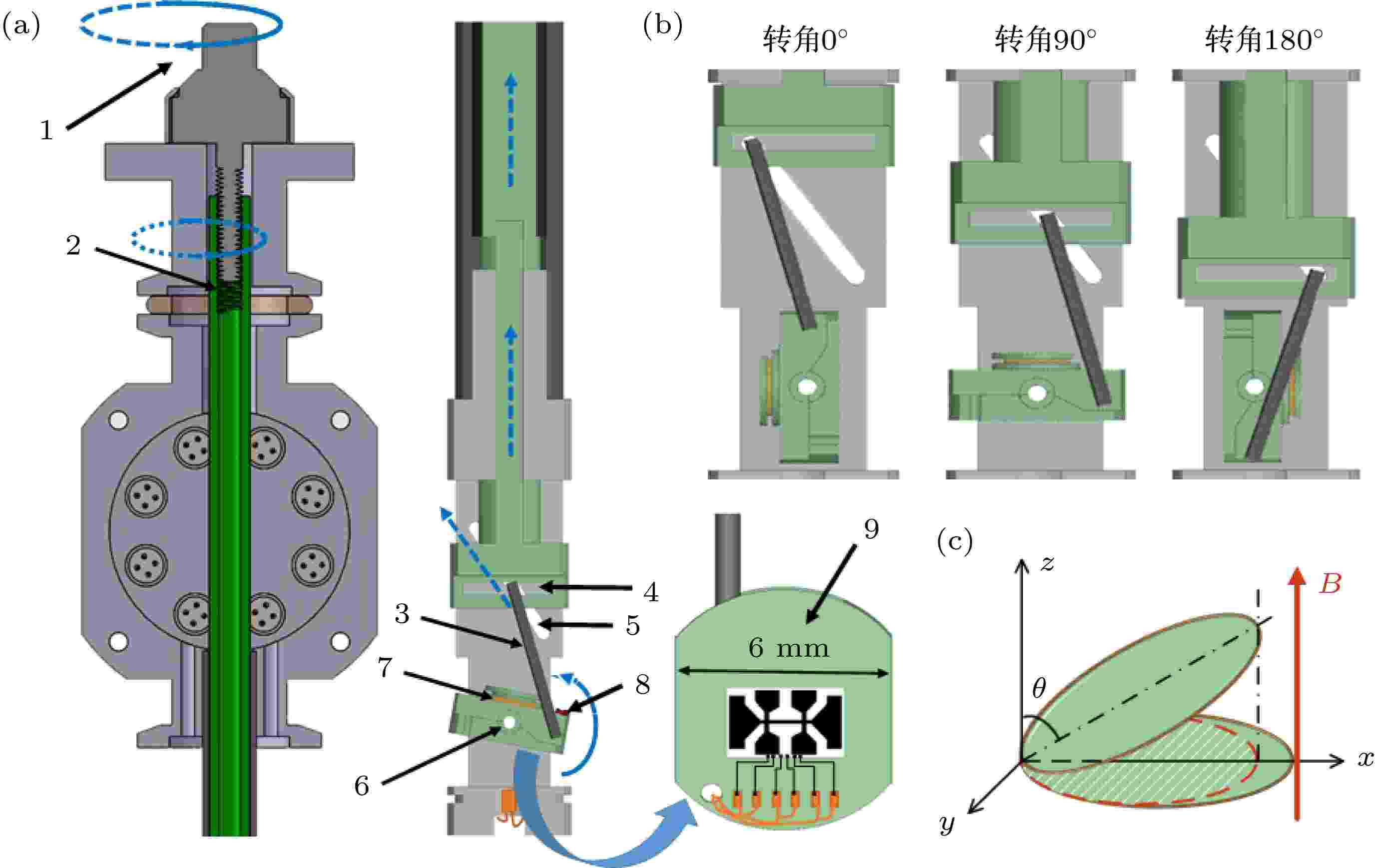 图 3 武汉强磁场中心转角样品杆 (a)机械结构图; (b) 转角示意图; (c) 角度标定原理图
图 3 武汉强磁场中心转角样品杆 (a)机械结构图; (b) 转角示意图; (c) 角度标定原理图Figure3. Rotation sample rod in WHMFC (Wuhan National High Magnetic Field Center): (a) Mechanical structure diagram; (b) situation at different angles; (c) principle of angle calibration.
2
3.2.旋转角度的精确控制
目前, 大多数商用转角样品测量杆在角度控制上没有角度值的实时反馈, 直接影响物理效应的测量效果. 针对这一问题, 设计的测量杆通过杆件底部角度标定线圈进行反馈控制, 实现旋转角度的精确控制. 先根据所需实验角度旋转旋钮, 此时旋钮示数反映期望值; 而旋转角度的实际值由角度标定线圈上感应电压根据空间投影原理计算得到; 对比期望值与实际值, 可以对控制旋钮进行快速反馈校正. 样品台空间几何示意图如图3(c)所示, 其旋转角度θ计算公式如下:此外, 由于拉杆结构远比滑轮结构稳定, 不受热胀冷缩影响, 因此可以在使用过程中可重复对照, 将角度控制旋钮上的刻度和θ角严格对应起来, 这种双重角度标定方法保证了角度旋转调节过程的严谨性, 可以达到0.1°的角度分辨率, 使样品杆的测量准确度得到了很大提高.
2
3.3.样品杆非金属选材与集成化布局设计
另一方面, 样品杆结构材料的选取对其性能稳定性好坏、使用寿命长短有着很大的影响. 脉冲场实验过程中, 磁体放电瞬间将产生一个很大的dB/dT值, 变化的电磁场在金属材料中形成涡流场, 引发的热效应会对实验环境的热稳定性造成影响, 同时伴随涡流产生的电磁干扰也会对样品微弱的本征信号造成干扰, 因此金属材料不宜作为脉冲场下的转角样品杆原材料. 此外, 由于实际情况下样品杆的零件需浸泡在最低1.3 K的液氦中, 而绝大多数非金属材料在这种极低温下脆性都会变大, 可能产生较大的形变, 从而影响转角杆性能的稳定性, 故而常规的非金属材料也不能满足要求. 考虑到上述问题, 我们经过反复调研、实验, 最终确定了聚醚醚铜(PEEK)作为转角样品杆主体框架结构材料. 这是一种新型特种工程塑料, 其耐温性、耐化学药品性、耐磨性、尺寸稳定性、绝缘性都表现优异, 且PEEK具有较低的热膨胀系数(约20 × 10–6/K), 与传动轴在实验中过程中相对形变量小于2‰, 严格控制了由于材料温升形变带来的角度控制误差, 进一步保证了样品杆测量过程中的稳定可靠.最后, 为了使样品杆在进行磁电阻、霍尔电阻、信号传输测量的同时, 兼具温度传感、加热控制等功能, 在样品台背面焊接贴片电阻以测量样品台温度, 在样品杆尾部缠绕线圈构成加热器, 绕线类型使用双绞型, 以避免感应电流对温控造成影响, 加热器在实验腔中通过氦气传热, 低温下保持了较高的导热效率. 基于如上设计, 于外部配套搭载了与实验需求相匹配的电气引线集成布局方案, 终端与测量杆顶部的高真空接头相连. 经过反复测试改良, 我们制作了基于杠杆结构的高精度转角样品测量杆, 宽度仅为8 mm左右, 成功达到电输运科学研究实验中脉冲磁体孔径的尺寸要求, 如图4所示.
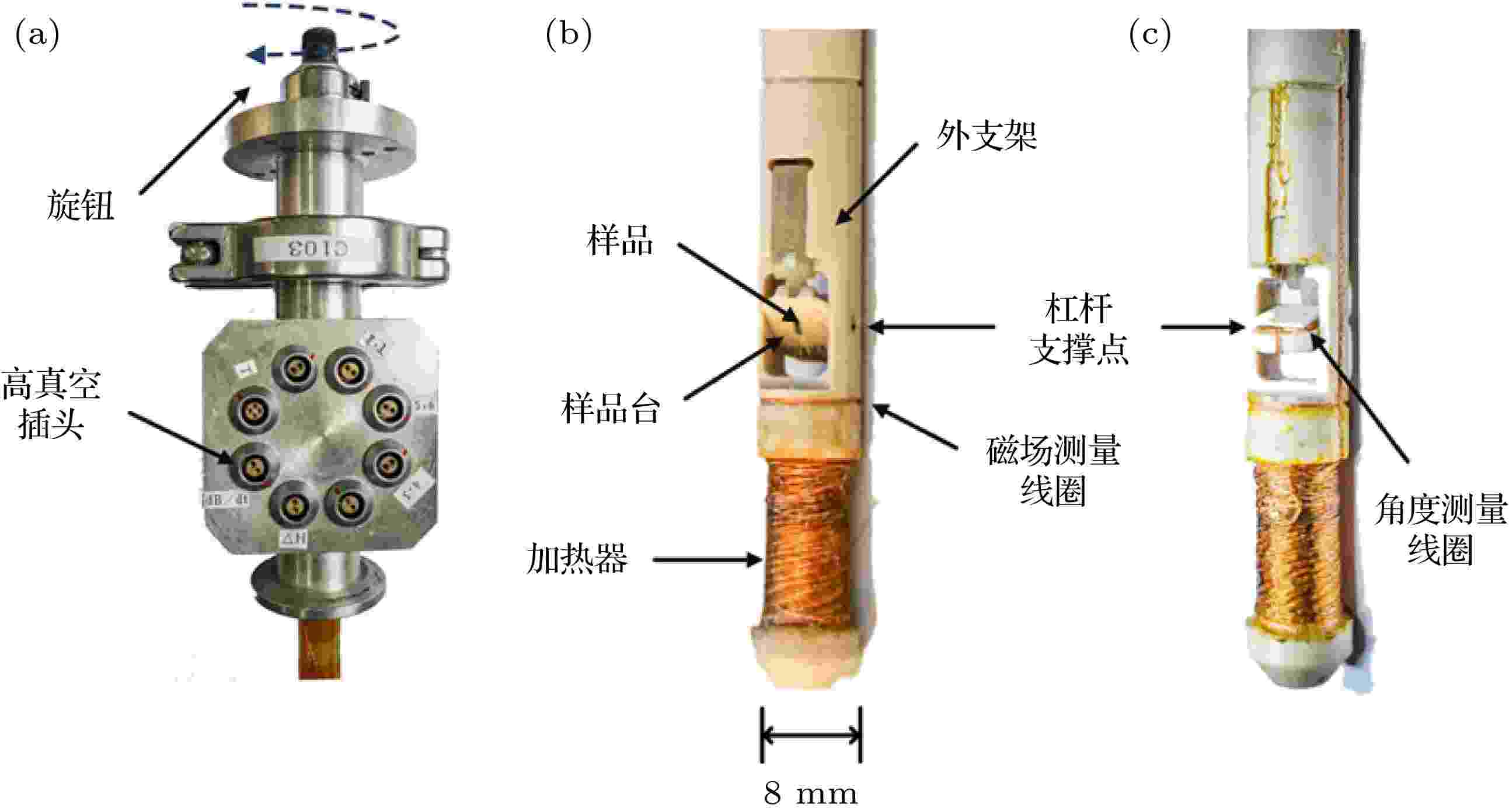 图 4 转角样品测量杆实物图 (a) 杆件顶部旋钮及引线罗盘; (b) 底部样品台正面; (c) 底部样品台背面
图 4 转角样品测量杆实物图 (a) 杆件顶部旋钮及引线罗盘; (b) 底部样品台正面; (c) 底部样品台背面Figure4. Physical diagram rotation sample rod: (a) Top part; (b) the front of the bottom sample stage; (c) the back of the bottom sample stage.
2
3.4.不同转角样品杆性能对比
表1列出了本文拉杆式样品杆与PPMS商用样品杆[8]、传统脉冲场拉绳式样品杆杆的参数对比[22,23], 可以看出我们研制的新型杠杆式样品杆在保证脉冲场测量范围足够大的同时, 在较小的空间孔径中实现了样品台空间利用的最大化, 并且保证了较高的角度分辨率.| 样品杆类型及参数 | 角度范围θ/(°) | 角度分辨率θ/(°) | 磁场范围B/T | 适应孔径d/mm | 样品台空间 |
| PPMS商用样品杆 | –10—370 | 0.05 | ± 16 (稳态) | 25 | 相对孔径较大 |
| 传统拉绳式样品杆 | 0—180 | 1.00 | > 60 (脉冲) | 9 | 相对孔径较小 |
| 新型拉杆式样品杆 | –5—185 | 0.10 | > 60 (脉冲) | 8 | 相对孔径较大 |
表1不同样品杆技术参数比较
Table1.Technical parameters of different kind of measurement rod.
2
3.5.基于转角样品杆的电输运测量过程
以半金属样品WTe2为例, 介绍本文转角样品杆在脉冲强磁场电输运测量系统中的实际操作步骤.第一步, 确定旋转角. 将WTe2样品焊接在样品台上, 根据研究目的确定所需角度范围为0°—90°, 选取0°, 35°, 45°, 60°, 75°, 90°为一组实验角度值, 转动旋钮控制样品台旋转量到估值附近, 操作脉冲电源对脉冲磁体放电产生脉冲磁场, 样品台背部角度标定线圈感应出实时转角并反馈至控制中心, 此时角度测量线圈与磁场测量线圈测得的信号如图5(a)所示, 由(1)式和(2)式可以计算得出此时样品的精确转角值为33°.
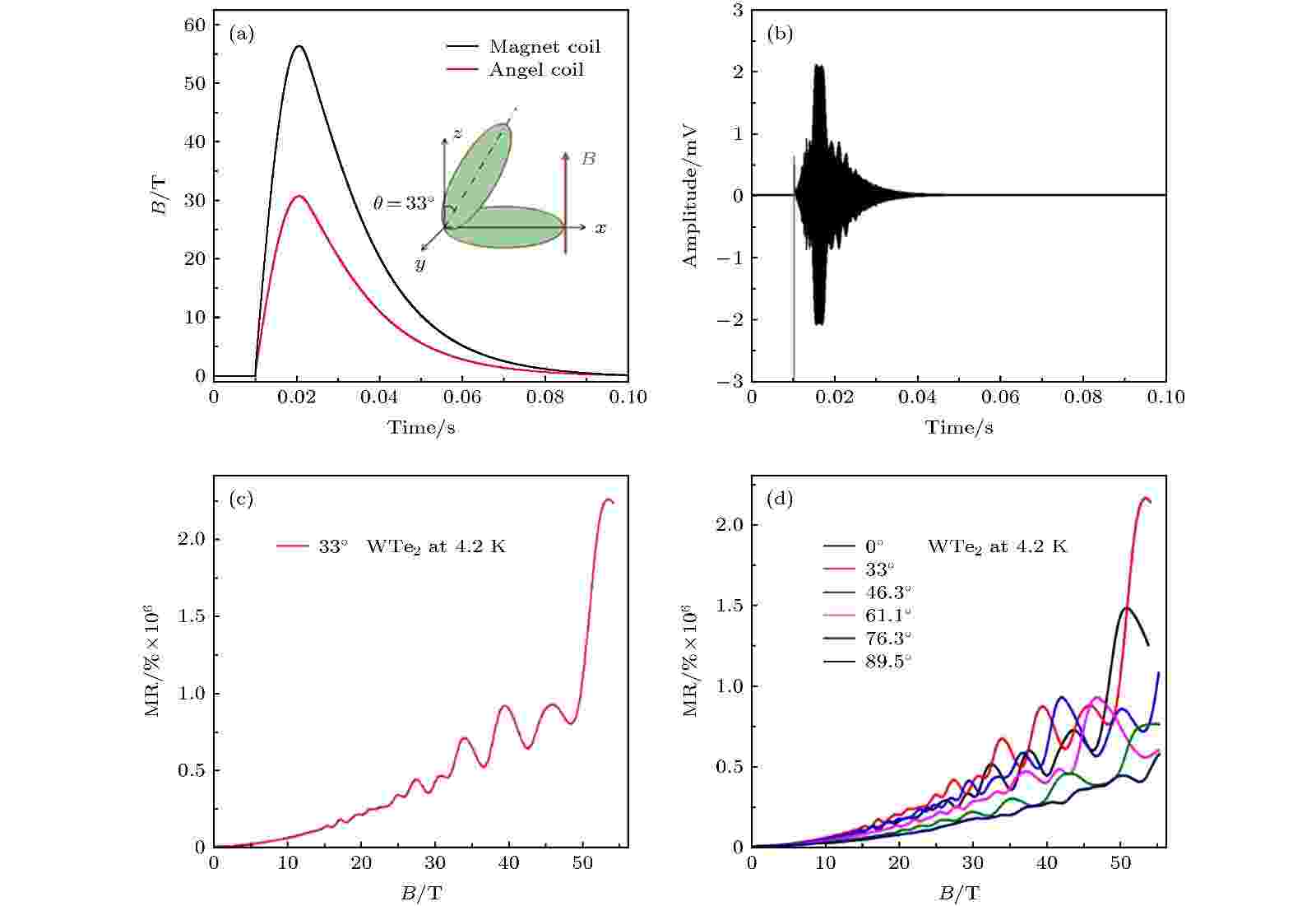 图 5 60 T脉冲强磁场下转角电输运实验相关数据处理过程
图 5 60 T脉冲强磁场下转角电输运实验相关数据处理过程Figure5. Signal processing of angular-dependent electrical transport experiment in 60 T pulsed high magnetic field.
第二步, 测量样品输运信号. 对样品通入高频电流, 通过四线法测量得到样品电压, 测量结果如图5(b)所示, 可以看出, 这一信号信噪比(signal-noise ratio, SNR)极小, 必须进行降噪信号处理.
第三步, 获得测试结果. 基于虚拟数字锁相放大(virtual digital lock-in amplify, VDLIA)的方法来计算并提取出微弱的样品磁电阻信号, 其相关计算原理可参考文献[24], 其结果分辨率可达0.1 mΩ. 处理完样品的B-T与Amp-T信号后, 将其拟合并得到这一角度下样品磁阻随磁场的变化曲线, 如图5(c)所示, 重复这一过程, 直到获得整组角度信息, 如图5(d)所示, 此时已经可以看出各个角度下清晰的SdH量子振荡现象.
实际测量过程中, 高速采集卡得到的所有信号经补偿、放大、数字处理单元后进入上位机总线, 通过光纤返回控制中心, 对脉冲磁体、脉冲电源、样品转角等参数进行反馈调节, 从而构成完整的脉冲强磁场下的转角电输运测量系统.
1)构造量子材料三维费米面结构. 费米面是动量空间中占据最高能级的等能面, 只有费米面附近的电子决定材料中的各类物理性质, 因此费米面结构的研究对探索材料的电学行为具有重要意义. 电输运测量实验中, 科研工作者通过旋转样品角度至不同的晶轴方向, 在强磁场下进行低温Shubnikov-de Haas效应测量SdH频率的角度依赖性, 根据昂色格(Onsager)关系推出不同角度下的费米面截面积, 从而构造三维费米面信息. 例如北京大学量子材料中心王健课题组[25]在武汉强磁场中心4.2 K, 60 T脉冲强磁场下, 观察到三维狄拉克半金属Cd3As2沿不同晶轴方向上的SdH振荡表现出显著的各向异性, 如图6所示. 通过分析各个角度下的磁阻振荡数据, 揭示出单晶Cd3As2的费米面是由两个嵌套在一起的椭球结构. 类似方法在研究重费米子超导体[26]、外尔半金属[27,28]、拓扑半金属[29]、过渡金属二硫化物[30]等体系中都获得了应用.
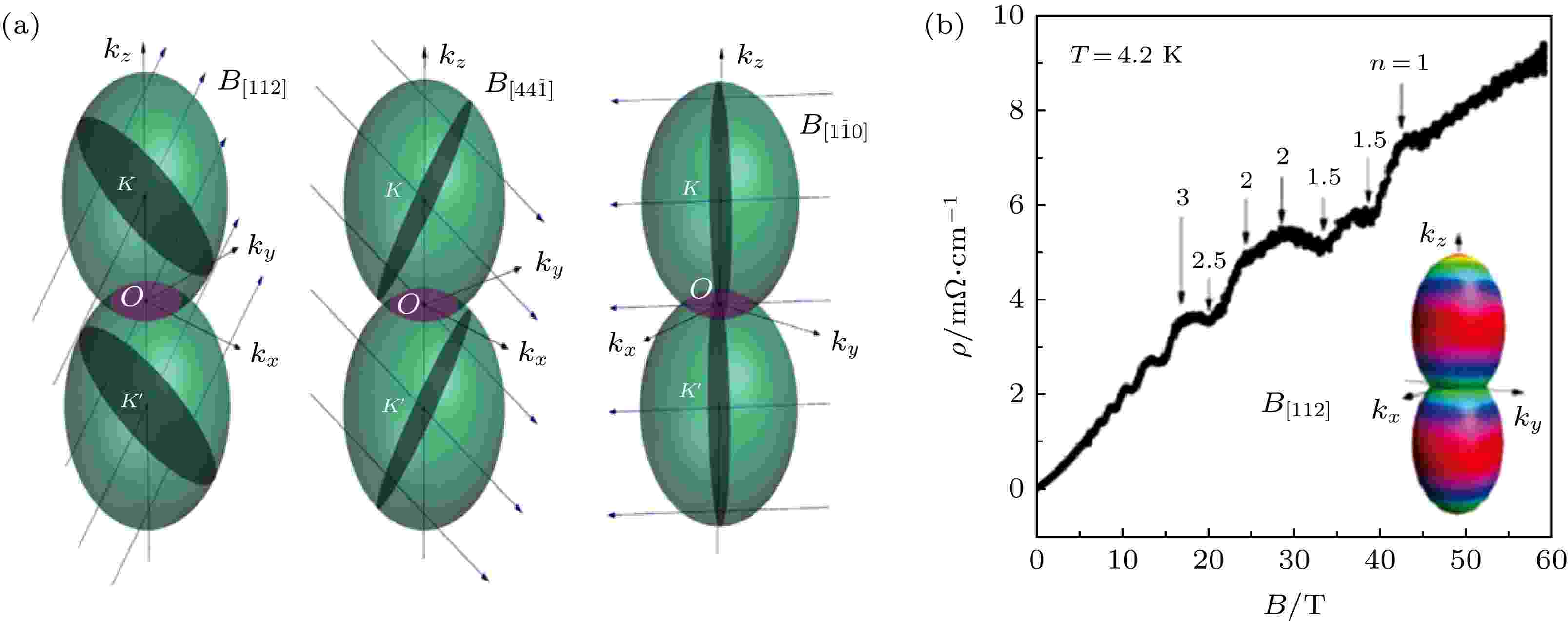 图 6 Cd3As2三维嵌套各向异性费米面构造图 (a) 不同晶轴方向的费米面最大横截面; (b) B[112]方向上的量子振荡
图 6 Cd3As2三维嵌套各向异性费米面构造图 (a) 不同晶轴方向的费米面最大横截面; (b) B[112]方向上的量子振荡Figure6. 3D nested anisotropic Fermi surface construction of Cd3As2: (a) Largest cross section of Fermi surface versus the magnetic field orientation; (b) quantum oscillation for B[112] direction.
2)研究拓扑绝缘体二维表面态特征. 这种无能隙的表面态完全由体电子态的拓扑结构所决定, 在时间反演对称性的保护下, 不会受到杂质和无序的影响, 在未来的自旋电子学和量子计算中有着巨大的应用潜力. 理论上, 三维拓扑绝缘体的体态是绝缘性的, 边界上存在着导电的二维表面态. 而实际中由于样品缺陷等原因, 三维拓扑绝缘体的体态并不完全绝缘, 因而对验证其无能隙的表面态带来了极大的干扰. 斯坦福大学材料与能源科学研究所Analytis等[31]在研究Bi2Se3晶体时将磁场提高到50 T左右, 使样品体态电子坍塌至朗道能级为零的量子极限状态, 此时在磁场中旋转样品, 发现如图7(a)所示的量子振荡现象仅仅依赖于磁场B的垂直分量, 这一奇特的SdH振荡信息为其二维表面态特征提供了明确的证据. 两年后, Tel Aviv University物理与天文学院Petrushevsky[32]也在强磁场环境下进行了类似实验, 结果如图7(b)所示, 表明SdH振荡频率与旋转角度呈明显的cosθ函数关系, 拓扑绝缘体Bi2Se3的二维表面态得到了进一步的证明.
 图 7 拓扑绝缘体Bi2Se3二维表面态特征 (a) 量子振荡现象[31]; (b) 振荡频率随转角的变化曲线[32]
图 7 拓扑绝缘体Bi2Se3二维表面态特征 (a) 量子振荡现象[31]; (b) 振荡频率随转角的变化曲线[32]Figure7. 2D surface state of a topological insulator Bi2Se3: (a) Quantum oscillation[31]; (b) frequency of the oscillations as a function of θ [32].
3)量子极限输运性质研究. 量子极限态指的是磁场到达一定强度时电子高度简并在最低朗道能带, 成为一种强关联体系, 此时样品会表现出许多新奇的物理性质. 武汉强磁场中心王俊峰与合作者利用65 T脉冲磁体, 通过一系列的变温和转角电输运测量, 对新型Weyl半金属TaP开展了强磁场下的转角电输运研究[33]. 如图7(a)所示, 在34.4 T的临界磁场下, TaP的霍尔信号发生明显反转, 由此证实了TaP的一对手性相反的Weyl点在强磁场下发生湮灭. 在量子极限范围下, 具有相反手性的Weyl点将被移动到同一动量坐标上, 电子的磁长度倒数与Weyl点的动量距离相比拟而发生磁隧穿效应时, 有可能实现能隙的打开以及Weyl费米子的湮灭. 该研究在国际上首次观察并证实了Weyl点的湮灭现象, 通过强磁场下的量子极限输运研究深刻揭示了Weyl费米子在强磁场下的非平庸拓扑性质. 文献[34]研究了元素Bi的输运性质, 通过测量SdH振荡周期的角度依赖性, 发现当进入量子极限状态时, 在某些特定角度下霍尔电阻率与磁场无关. 文献[35]则描述了Bi在量子极限状态外的极大不稳定性, 通过–10°—10°的转角测量, 发现在磁场强度40 T时, 超量子体系的输运特性表现出了显著不与角相关的电子不稳定性, 增强了导电率的绝对值和金属温度的依赖性, 见图8(b).
 图 8 脉冲强磁场下的半金属材料量子极限输运研究 (a) TaP; (b) Bi
图 8 脉冲强磁场下的半金属材料量子极限输运研究 (a) TaP; (b) BiFigure8. Quantum limit electrical transport of semi-metal materials in pulsed high magnetic fields: (a) TaP; (b) Bi.
4)探索超导材料的超导电性. 超导是凝聚态物质中电子的一种宏观多体量子态, 同时满足零电阻和迈斯纳效应两个物理性质, 其中发现的种种奇异量子现象是现代基础科学研究的重要源泉, 在能源、医疗、通信等领域都有着广泛的应用前景. 武汉强磁场中心左华坤及其合作者进行了准一维铬基砷化物超导材料K2Cr3As3在强磁场下的转角电输运实验, 得到如图9所示的实验结果[36], 可以看出上方临界场中的各向异性随温度的降低成反比关系, 在θ = 0°和θ = 90°时取最大值(远超泡利顺磁极限), 其正常态表现出具有线性电阻率的非费米液体行为, 并且在低温下显示出独特的三重调制, 表明这类准一维铬基材料可能具有非常规的自旋-三重态超导电性.
 图 9 超导材料K2Cr3As3的转角电输运实验结果 (a) π/2处出现上方临界场(Hc2)的最大值表明了泡利极限的缺失; (b) 极坐标图则体现了Hc2的三重调制性
图 9 超导材料K2Cr3As3的转角电输运实验结果 (a) π/2处出现上方临界场(Hc2)的最大值表明了泡利极限的缺失; (b) 极坐标图则体现了Hc2的三重调制性Figure9. Electrical transport of the superconducting material K2Cr3As3: (a) The maximum value of the upper critical field (Hc2) at π/2 indicates the absence the Pauli paramagnetic effect; (b) the polar map of Hc2 shows a unique three fold modulation.
本文研制的脉冲强磁场转角电输运测量系统, 突破了目前大多数电输运实验系统磁场强度有限、样品台空间利用率低下、转角估值不准的瓶颈, 实现了在极端环境下对微小样品腔中对样品姿态的精确控制, 基于此完成了不同磁场方向下的各类角度相关的电输运测量研究. 相关实验成果表明, 该类系统在三维费米面分析、拓扑表面态判断、量子极限输运探测、超导电性分析等方面的研究具有重要应用价值. 基于此系统, 武汉强磁场中心取得了一批丰硕的研究成果, 并为国内外相关研究团队在强磁场、极低温环境下探索量子材料本征物理性能和机制提供了一种有效研究手段.
